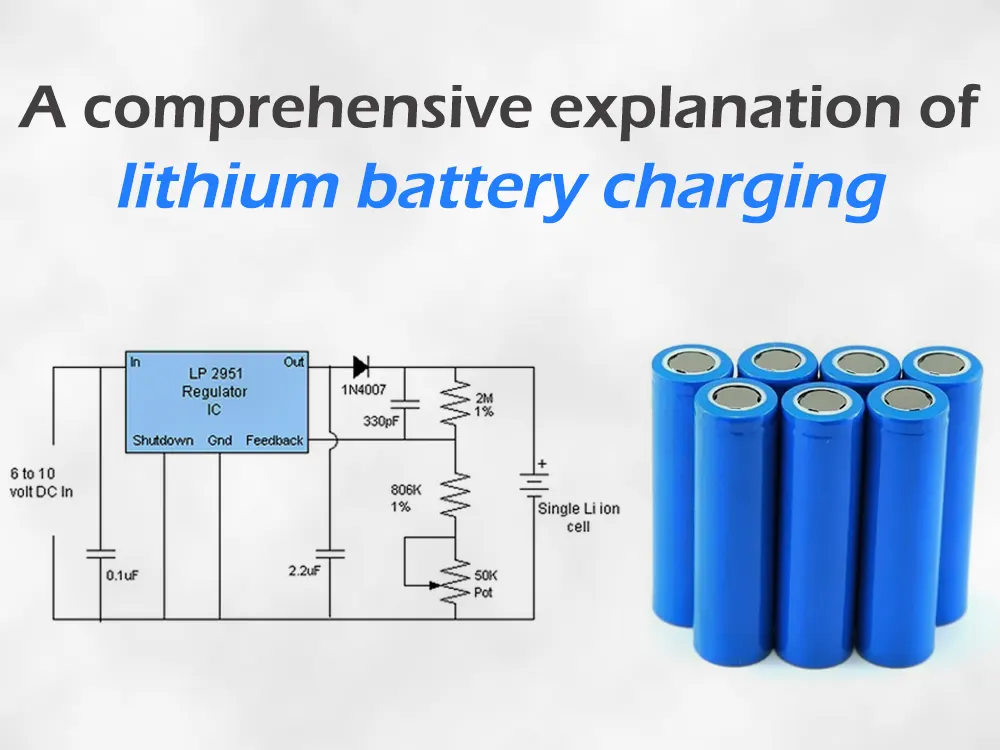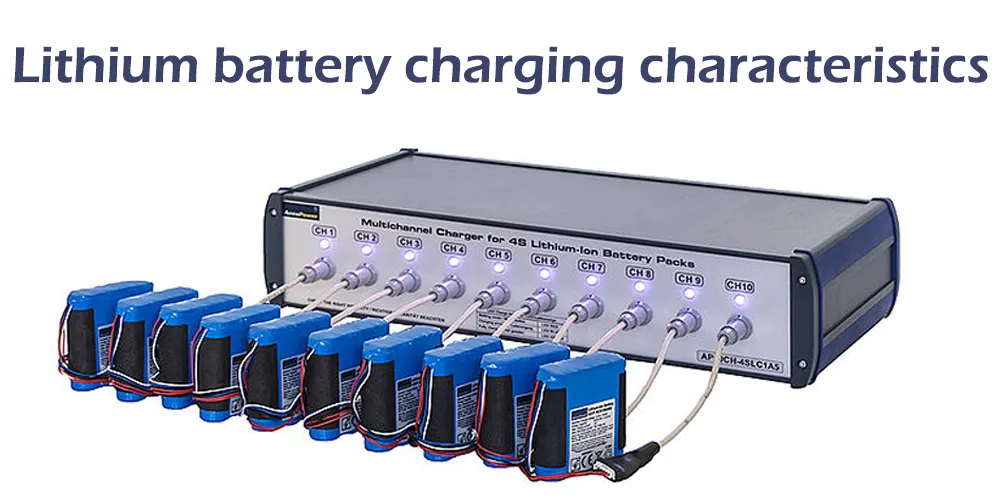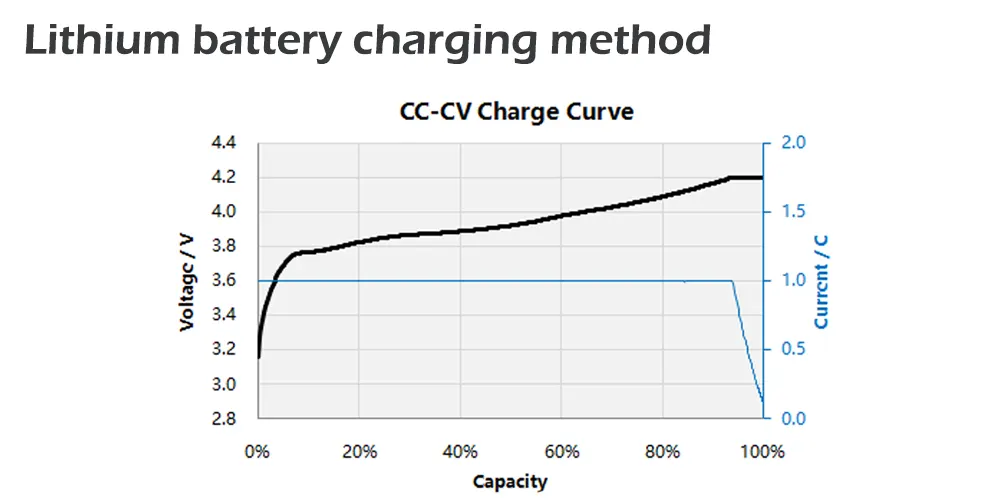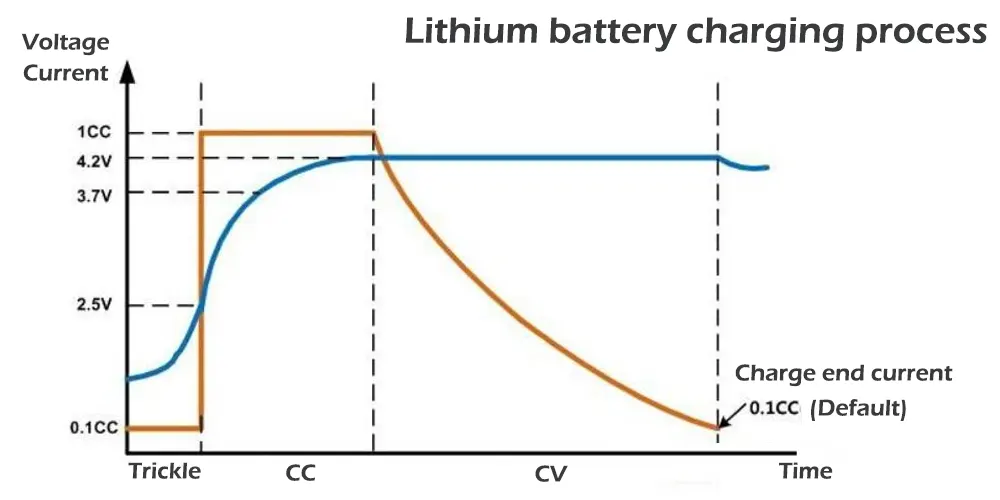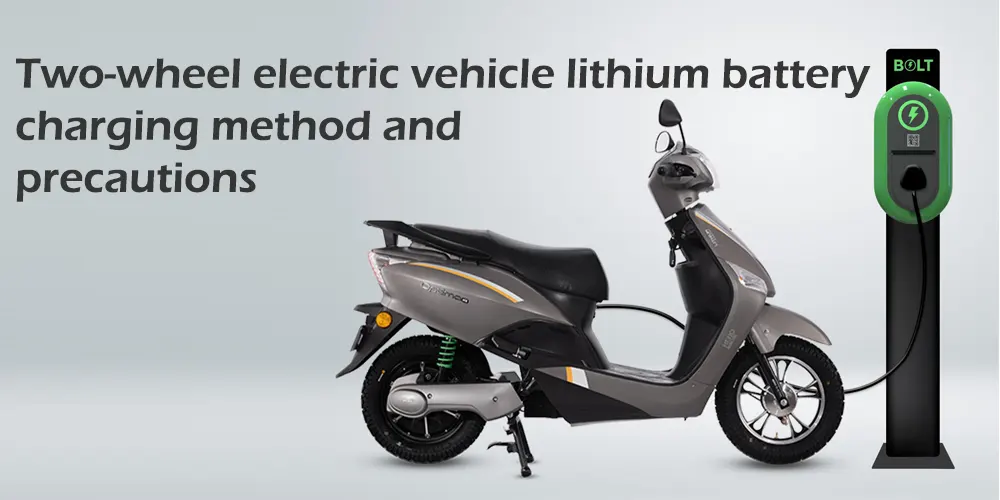A comprehensive explanation of lithium battery charging

Lithium battery charging characteristics
During the lithium battery charging process, the voltage and charging current of the battery will change with the charging time.
Lithium battery charging needs to control its charging voltage, limit charging current and accurately detect battery voltage. Compared li-ion vs ni-mh battery vs ni-cd battery, the charging characteristics of lithium-ion batteries are completely different from those of nickel-cadmium and nickel-metal hydride.
A lithium-ion battery can be charged at any point in its discharge cycle and can hold its charge very efficiently, more than twice as long as a Ni-MH battery.
When the lithium-ion battery starts charging, the voltage rises slowly, and the charging current gradually decreases. When the battery voltage reaches about 4.2V, the battery voltage basically remains unchanged, and the charging current continues to drop.
The way to judge whether the charging of lithium-ion battery is over is to detect its charging current, and when its charging current drops to a certain value (that is, what we usually call the charging cut-off current), the charging ends.
For example, charging ends when the charging current of a lithium-ion battery drops to 40mA (typically about 5% of the initial charging current).
It is also possible to start the timer when detecting that the lithium battery reaches 4.2V, and end charging after a certain time delay. At this time, the charging circuit should have a battery voltage detection circuit with high precision to prevent the lithium-ion battery from being overcharged.
Lithium battery charging method and process
Lithium battery charging has different ways, among which the standard lithium battery charging method is CC-CV charging. At present, the mainstream lithium battery charging method is still dominated by CC-CV, because lithium batteries have polarization phenomenon (instant voltage is not steady-state voltage). It is worth reminding that only a special lithium battery charger can achieve this mode.
Constant current and constant voltage charge (CC-CV charge for short), this charging method is the combination of CC charging and CV charging. During the charging process, the current is kept constant first.
When the voltage is charged to the upper limit voltage, the voltage is kept constant. Finally, the current is gradually reduced to the set value and the charging ends.
The most suitable charging process for lithium-ion batteries can be divided into four stages: trickle charging, constant current charging, constant voltage charging and charging termination.
Phase 1: Trickle Charge – Trickle charge is used to precharge fully discharged cells first (recovery charge). When the battery voltage is lower than about 3V, first use the maximum constant current of 0.1C to charge the battery.
Phase 2: Constant current charging – When the battery voltage rises above the trickle charging threshold, the charging current is increased for constant current charging.
The constant current charging current is between 0.2C and 1.0C. The battery voltage gradually increases with the constant current charging process. Generally, the voltage set for a single battery is 3.0-4.2V.
Phase 3: Constant voltage charging – When the battery voltage rises to 4.2V, the constant current charging ends and the constant voltage charging phase begins.
CV charging mode, that is, float charging mode or slow charging, the battery voltage no longer rises, and the charging current slowly decreases until the charging current is less than 0.1C, and the charging is completed at this time.
Phase 4: Termination of Charge – Unlike nickel batteries, continuous trickle charging of Li-Ion batteries is not recommended. Continuous trickle charging will lead to plate plating effect on lithium metal.
This destabilizes the battery and has the potential to cause a sudden automatic rapid disassembly. There are two typical charge termination methods:
● Use the minimum charging current to judge or use a timer (or a combination of the two). The minimum current method monitors the lithium battery charging current during the constant voltage charging phase and terminates charging when the charging current decreases to the range of 0.02C to 0.07C.
● The second method counts from the beginning of the constant voltage charging phase, and terminates the charging process after two hours of continuous charging.
Can a lead-acid battery charger be used to charge lithium battery?
No. Since lead-acid battery chargers are generally set to a two-stage or three-stage charging mode, the voltage levels of lithium batteries and lead-acid batteries do not match. There are also many kinds of lithium batteries, and the battery performance and battery protection board parameters may be different.
Therefore, lithium batteries do not have universal battery charger like lead-acid batteries. Generally speaking, lithium batteries are equipped with special chargers when they leave the factory. In order to protect the lithium battery, a special charger is required.
The following are the precautions for lithium battery charging process:
● To prevent high current charging, generally not more than 1C, 0.2C is recommended, excessive current will damage the battery life
● It is forbidden to charge at high temperature (45°C)
● It is forbidden to reverse charge the battery
● It is forbidden to use a charger with an unmatched voltage for charging
● It is forbidden to short-circuit the charging line
Two-wheel electric vehicle lithium battery charging method and precautions
● After the implementation of the new national standard for two-wheel electric vehicles, electric motorcycle battery packs have become more and more common in the market, but many people do not know the correct lithium battery charging method for two-wheel electric vehicle lithium batteries.
● In high temperature weather, it is not allowed to charge under the sun, and it cannot be charged immediately after driving. This is especially important. In the same way, keep away from open flames and high-temperature heat sources no matter in normal times or when charging.
● When the two-wheeled electric vehicle is running and there is a warning that the battery is too low, it should be charged as soon as possible. After the battery is discharged, the vulcanization process begins, and charging in time can remove the non-serious vulcanization.
● Be sure to charge with a suitable lithium battery charger. First, insert the charger output plug into the battery charging socket, then insert the charger plug into the mains jack, and observe the indicator light for charging judgment.
If the charger is lost or damaged, please find the corresponding dealer to buy it. Do not use lead-acid chargers or other forms of chargers for lithium battery charging.
● As far as possible, the lithium battery pack should be charged along with use, so as to avoid charging the battery after every undervoltage, which can greatly improve the battery life, so that the battery is in a shallow cycle state, so that the battery life will be extended.
● Avoid high temperature charging, high temperature will make the battery capacity decline. Try to choose a cool and ventilated environment. Too hot an environment is not conducive to the charging state, and will damage the battery and reduce the life of the charger.
● If the two-wheeled electric vehicle is not used for a long time, the battery should be disconnected from the vehicle, and some power should be added to the battery at intervals.
Lithium batteries are not allowed to be stored empty. If the lithium battery is not used for a short time, please charge the battery to more than 50% for storage. It is best to recharge the battery every month.
● When charging the battery, if the plug of the charger is continuously heating, and the heating time is relatively long, it is necessary to check immediately whether the plug is short-circuited or in poor contact.
The charger should be pulled out, check for oxides on the plug, such as rust, and then remove it immediately.

